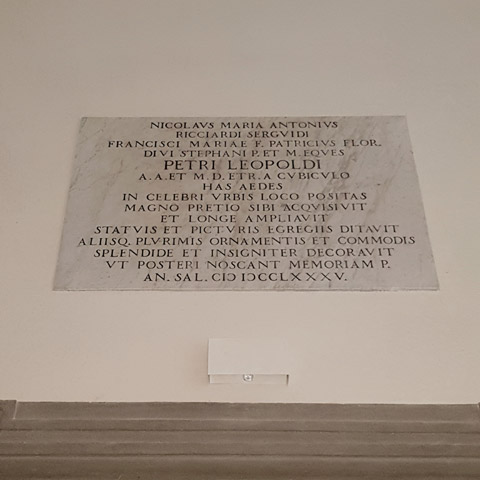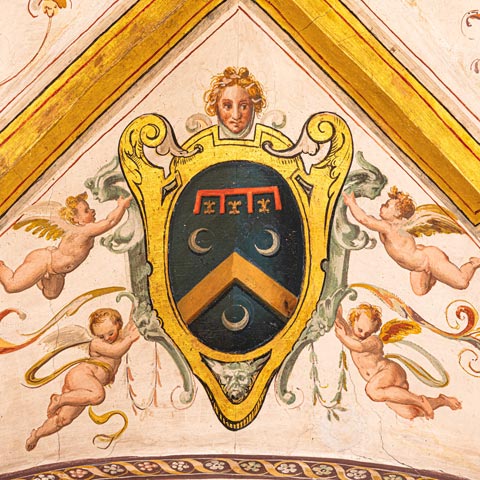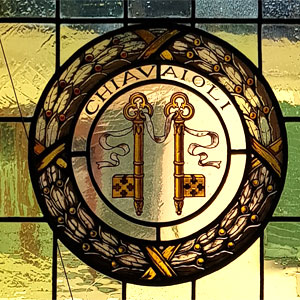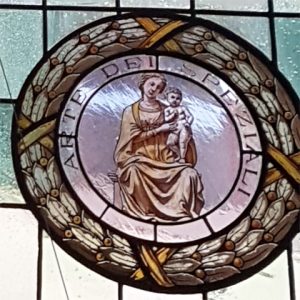Reinassance
Museum
During your stay at Palazzo Portinari Salviati you will not only get to know its history from the mid-1200s, but directly admire the artistic works that really make it “Your Place in History”. If your dream has always been to sleep in a Renaissance Museum in Florence, here you can make it happen.
Following a brief introduction to the artistic and architectural artworks
The
Courtyards

Cosimo I
courtyard

Cosimo I courtyard
Period: fifteenth century (1470/80)
Architect: Michelozzo di Bartolomeo (attribution by G. Pampaoloni)
Composite capitals (with Corinthian leaves and Ionic volutes)
At the centre: statue of Cosimo I de’ Medici in lorica cuirass. The marble sculpture consists of a fragmentary Roman statue in lorica cuirass (the lorica is a form of ancient Roman armour) to which the head of Grand Duke Cosimo I de’ Medici was added, executed by Giovan Francesco Susini (Florence, c. 1585- Florence, 17 October 1653) who worked in the workshop of Giambologna.
Inscribed (on the base of the sculpture):
HAS INTER/MATERNAS AEDES/PUER REPTAVIT/ COSMUS/ QUAS NUNC STABILI/FULCIT PEDE/IN DIADEMATIS MAIESTATE
Free translation: IN THESE MATERNAL ROOMS, COSIMO CRAWLED AS AN INFANT, (HE) WHO NOW WITH FIRM STANCE RADIATES IN THE MAJESTY OF THE DIADEMS)

Madonna
and Child

Madonna and Child
Fresco: Madonna and Child between Saint John the Baptist and Saint Zenobius.
Date: Thirteenth century.
In the centre: the Madonna and Child enthroned in the iconography known as the Maestà. Paintings ‘in maestà’ depict an enthroned figure. It may be Christ (Maiestas Domini) or other figures, but most often it is the Madonna seated with the baby Jesus in her arms, sometimes surrounded by angels and saints. On the left stands St John the Baptist, patron saint of Florence, recognisable by his camel skin and astylar cross.
On the right, we see Saint Zenobius, the first saint and bishop of Florence.
Zenobius lived between the fourth and fifth centuries and performed many miracles. His relics are preserved in the Duomo in a coffer designed by Lorenzo Ghiberti.

Memorial
plaque

Memorial plaque of Rodolfo Arnoldo Burgisser
Rodolfo Arnoldo Burgisser (Wohlen, CH 1856 – Luzern, CH 1 1922). Swiss-born, he founded a straw factory in Florence for making hats and other items; between the nineteenth and twentieth centuries he extended his business activity, though always guided by a Christian and social spirit. He was the first chairman of Banca Toscana. The Bank was founded in Florence on 4 April 1904 under the name of Piccolo credito toscano, a cooperative society with unlimited capital, promoted by a committee of citizens from different social backgrounds, mostly artisans, merchants and farmers. The Bank, which had its first headquarters in Via del Corso 3, was a credit institution of Catholic inspiration: the first Board of Directors was composed of a Monsignor, a Canon and a lawyer and was chaired by Rodolfo Arnoldo Bürgisser (Swiss, founder of the Libreria editrice fiorentina – LEF).

Dedicatory
plaque

Dedicatory plaque to Pietro Leopoldo commemorating Eighteenth-century works
A marble plaque dated 1785 with a dedication to Grand Duke Pietro Leopoldo of Lorraine regarding the extension and decoration of the palazzo, which was adorned with statues and paintings by Niccolò Maria Ricciardi Serguidi. The palazzo was purchased on 22 June 1768 by Niccolò Maria Ricciardi, who had taken the surname Serguidi.

Emperor’s
courtyard

Emperor’s courtyard
The space derives its name from the twelve bronze heads that were inserted in the niches (no longer present).
Frescoes: Stories of Ulysses and Stories of Hercules.
Artist: Alessandro Allori and assistants (Giovanni Maria Butteri, Giovanni Bizzelli , Alessandro di Benedetto identifiable as Alessandro Pieroni).
Date: 1575-1576
Stories of Ulysses: the barrel-vaulted ceiling is divided into 6 panels with episodes from the Odyssey, with the scenes framed by bands decorated with grotesques.
Stories of Hercules: Alessandro Allori and assistants.

Serguidi
Crest

Serguidi Crest
Azure with golden chevron (a chevron indicates a bar or a band joined at an angle, pointing upwards) accompanied by three silver crescents placed two at the head and one at the tip, and overall an Anjou chief.

Ricciardi
Crest

Ricciardi Crest
Tierced per gold fess charged with hedgehog: azure in the first; silver in the second with mullet of eight points.

Skylight

Ceiling (glazed) with Allegory of Abundance, Emperors’ Courtyard
Artist: Francesco Mossmeyer (Paris 1851/Florence 1934) was a painter and restorer of stained glass, active in Florence between the end of the nineteenth century and the early decades of the twentieth century, with a workshop on a par with others in Florence such as Polloni and De Matteis.
Date: 1922
The surface of the skylight is divided into squares and rectangles decorated with grotesques. In the centre is a female figure sitting by a flowered balustrade, pouring coins from a cornucopia. The figure can be identified as the nymph Amalthea, personification of prosperity, from whom the Roman Copia or Abundance derives.

Room Francesco I de’ Medici

Room Francesco I De’ Medici
WOODEN CEILING: upper frieze fifteenth century, lower band decorated in the sixteenth century.
PORTINARI CREST: The Portinari crest (‘canting arms’ i.e. that ‘sing’ the family name) shows a door between two rampant lions.
SALVIATI CREST: Silver and red bretessed bends. As can be seen, when the Portinari coat of arms passed to the new owners in the sixteenth century, it was abraded and replaced by that of the Salviati.
FIREPLACE: pietra serena, the Portinari coat of arms in the border; central floral painting

Room Maria de’ Medici

Room Maria De’ Medici
Fresco: Marcus Curtius casting himself into the chasm
Artist: Tommaso Gherardini and assistants (1783/1784)
Tommaso Gherardini (Florence 1715-Florence 1797). After studying with the sculptor Piamontini and with Vincenzo Meucci, he attended the academies of Venice and Bologna before 1740, when he is mentioned in the registers of the Florentine Academy.
Subject: Marcus Curtius is a legendary Roman knight. In 362 BC, after a chasm suddenly appeared in the Forum that could only be filled by the sacrifice of what the Romans considered most precious, and believing that nothing was more precious than weapons and valour, cast himself into it armed and on horseback; the place was called lacus Curtius. This self-sacrifice to the underworld gods (Mani) was called devotio. In paragraph 6 of book VII of his work Ab Urbe condita, Livy speaks of a young Roman soldier who distinguished himself in battle and offered himself to the gods Mani. Varro, in paragraph 148 of book V of De Lingua Latina and Pliny in Naturalis Historia mention the same legend.

Gallery

Gallery
Fresco: Olympus
Artist: Tommaso Gherardini, initialled T.G. and dated 1783 (along the frame of the left side)
Subject: Olympus. The following divinities can be identified: Jupiter, Juno and Hebe (cupbearer of the gods); Apollo and Diana; Night; Pluto with Cerberus, Proserpine and Mercury; Bacchus with satyrs; Venus and Mars; Neptune and Athena.

Room
Federico IV

Room Federico IV
Fresco: The Four Seasons (Spring, Summer, Autumn, Winter).
Artist: Tommaso Gherardini and assistants (1783)
Spring is depicted as a young woman with a garland of flowers in her hair and hands; Summer is depicted as a woman with ears of corn in her hair and a mirror in her left hand; Autumn is depicted as a naked man crowned with vines and grapes and holding bunches of grapes in his hands; Winter is depicted as an old man, naked, with his head wrapped in a cloak and trembling from the cold.

Room Beatrice Portinari

Room Beatrice Portinari
Fresco: Allegory of Night
Artist: Tommaso Gherardini and assistants (1783)
Iconography: Night is depicted as a young woman wrapped in a blue cloak
(symbol of the sky) holding two children in her arms: Hypnos (Sleep) and Thanatos (Death). The two are twins. For the iconography of Night, Sleep and Death see Homer (Iliad), Hesiod (Theogony), Virgil (Aeneid).
Noble Floor
Stained glass windows

Art of silk

Art of silk
This was a Major Guild. It brought together merchants, retailers of fabrics, merchants, goldsmiths, bonnet-makers, hat-makers, shoemakers, doublet-makers, mattress-makers and makers of arts. Crest: silver with red door.

Arte degli Oliandoli e pizzicagnoli

Arte degli Oliandoli e pizzicagnoli
(Minor guild). It brought together retailers of oil, cheese, sausages and other gastronomic products.
Crest: silver with red lion holding a green olive branch in its limbs.

Art of Judges and Notaries

Art of Judges and Notaries
(Major guild).
Crest: Azure, with gold mullet of eight points.

Arte
del Cambio

Arte del Cambio
(Major Guild). Activities: Money exchange, trading in precious stones and metals, lending, credit and deposit.
Crest: red with gold coins.

Arte dei Correggiai Tavolacciai e Scudai

Arte dei Correggiai Tavolacciai e Scudai
(Minor Guild). The correggiai were the makers of belts. Activities: Leather working for belts, straps, shields, saddles. Crest: Silver per fess, the second silver with three red undy pales.

Arte dei Vaiai e Pellicciai

Arte dei Vaiai e Pellicciai
(Major Guild). Activities: Import and processing of furs and hides.
Crest: Vair, the Agnus Dei with pennon of the People of Florence in the upper right-hand canton. Vair is a term used in heraldry to indicate heraldic fur. The Agnus Dei or Easter lamb indicates a special image in the symbolism of ecclesiastical art: a lamb bearing a cross, representing Christ.

Arte dei
Vinattieri

Arte dei Vinattieri
(Minor Guild). Activities: Production and wholesale and retail sale of wine. Coat of arms: Silver with a red goblet.

Arte dei Mercatanti o di Calimala

Arte dei Mercatanti o di Calimala
(Major Guild). Activities: Dealers in imported raw textile products and exported processed textiles of high value.
Crest: Red, with eagle grasping a silver torsello. A torsello is a bale of cloth or rolled-up linen.

Arte dei
Chiavaioli

Arte dei Chiavaioli
(Minor Guild). Activities: Key and lock manufacturers, ironmongers, locksmiths, boilermakers, needle-makers, gimlet-makers, watchmakers.
Crest: Red, two silver keys on pale, leaning against each other and tied with a ribbon.

Arte dei
Legnaioli

Arte dei Legnaioli
(Minor Guild). Activities: Woodworking.
Crest: Silver with leafy and uprooted tree with a wooden box overall.

Arte degli
Speziali

Arte degli Speziali
(Major Guild). Activities: Doctors, apothecaries, and also painters were associated with the Arte degli Speziali.
Crest: Silver, the Virgin with Christ with arm around her neck natural.

Arte della
Lana

Arte della Lana
(Major Guild). Activities: Wool processing and weaving, all workers involved in processing functions.
Crest: Azure with the Agnus Dei natural, and overall an Anjou chief.

